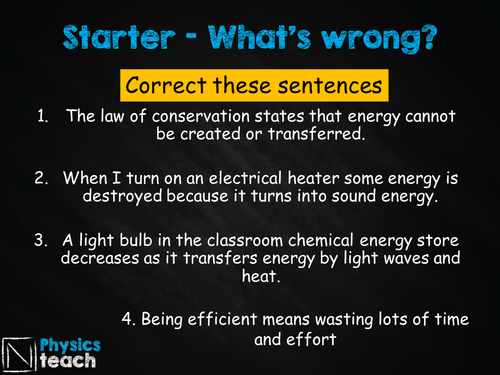
New GCSE AQA Physics lesson on 'Energy and Efficiency' written in line with new AQA Physics specification.
The lesson can start with either a task to correct statements provided about energy or to discuss what happens to wasted energy.
Different types of bulbs are shown through images which pupils are likely to have comes across, they are then prompted to discuss how they are different and why we use different ones, this lead to talking about efficiency.
Useful and wasted energy are explained and related to context and energy flow diagrams previously used. Also a key explanation of what happens to wasted energy is given. Pupils must then identify whether particular energy changes are useful or wasteful for certain devices.
Energy efficiency is detailed to students and then presented as 'units of energy' in a form similar to sankey diagrams (which are no longer required by AQA but can help students rationalise percentages). A class activity is outlined which requires groups of pupils to shown how energy is split by different devices and can help students visually see how portions of energy are distributed. Following this the energy equation is given which is then used by two sets of review questions.
The lesson concludes with content for higher tier students which looks at ways energy waste can be reduced.
Lesson Objectives:
1) Explain what is meant by useful and wasted energy.
2) Explain what eventually happens to wasted energy.
3) Calculate the energy efficiency of different appliances.
4) Detail how energy transfers can be made more efficient. (Higher tier only)
The lesson can start with either a task to correct statements provided about energy or to discuss what happens to wasted energy.
Different types of bulbs are shown through images which pupils are likely to have comes across, they are then prompted to discuss how they are different and why we use different ones, this lead to talking about efficiency.
Useful and wasted energy are explained and related to context and energy flow diagrams previously used. Also a key explanation of what happens to wasted energy is given. Pupils must then identify whether particular energy changes are useful or wasteful for certain devices.
Energy efficiency is detailed to students and then presented as 'units of energy' in a form similar to sankey diagrams (which are no longer required by AQA but can help students rationalise percentages). A class activity is outlined which requires groups of pupils to shown how energy is split by different devices and can help students visually see how portions of energy are distributed. Following this the energy equation is given which is then used by two sets of review questions.
The lesson concludes with content for higher tier students which looks at ways energy waste can be reduced.
Lesson Objectives:
1) Explain what is meant by useful and wasted energy.
2) Explain what eventually happens to wasted energy.
3) Calculate the energy efficiency of different appliances.
4) Detail how energy transfers can be made more efficient. (Higher tier only)
Get this resource as part of a bundle and save up to 44%
A bundle is a package of resources grouped together to teach a particular topic, or a series of lessons, in one place.
Something went wrong, please try again later.
I love NTeach resources for Physics GCSE; the PPTs cover the scheme of work perfectly, clear and easy to understand for non-specialists, you can open them up & run with them with little or no modifications. Great work - thanks!
Report this resourceto let us know if it violates our terms and conditions.
Our customer service team will review your report and will be in touch.
£3.00
